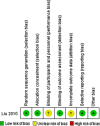Balloon kyphoplasty versus percutaneous vertebroplasty in treating osteoporotic vertebral compression fracture: grading the evidence through a systematic review and meta-analysis
- PMID: 22832872
- PMCID: PMC3459117
- DOI: 10.1007/s00586-012-2441-6
Balloon kyphoplasty versus percutaneous vertebroplasty in treating osteoporotic vertebral compression fracture: grading the evidence through a systematic review and meta-analysis
Abstract
Objective: To assess the safety and efficacy of balloon kyphoplasty (KP) compared with percutaneous vertebroplasty (VP) and provide recommendations for using these procedures to treat osteoporotic vertebral compression fractures (OVCF).
Methods: A systematic search of all studies published through March 2012 was conducted using the MEDLINE, EMBASE, OVID, ScienceDirect and Cochrane CENTRAL databases. The randomized controlled trials (RCTs) and non-randomized controlled trials that compared KP to VP and provided data on safety and clinical effects were identified. Demographic characteristics, adverse events and clinical outcomes were manually extracted from all of the selected studies. The evidence quality levels and recommendations were assessed using the GRADE system.
Results: Twelve studies encompassing 1,081 patients met the inclusion criteria. Subgroup meta-analyses were performed according to the study design. In the RCT subgroup, there were significant differences between the two procedures in short-term visual analog scale (VAS), long-term kyphosis angles, operative times and anterior vertebrae heights. In the cohort study subgroup, there were significant differences between the two procedures in short- and long-term VAS, short- and long-term Oswestry Disability Index (ODI), cement leakage rates, short- and long-term kyphosis angles, operative times and anterior vertebrae heights. However, there were no significant differences in long-term VAS or adjacent vertebral fracture rates in the RCT subgroup. There were no significant differences in short- or long-term VAS, short- or long-term ODI, cement leakage rates, adjacent vertebral fracture rates, short- or long-term kyphosis angles or anterior vertebrae heights in the CCT subgroup, and the adjacent vertebral fracture rates did not differ significantly in the cohort study subgroup. The overall GRADE system evidence quality was very low, which lowers our confidence in their recommendations.
Conclusions: KP and VP are both safe and effective surgical procedures for treating OVCF. KP may be superior to VP in patients with large kyphosis angles, vertebral fissures, fractures in the posterior edge of the vertebral body or significant height loss in the fractured vertebrae. Due to the poor quality of the evidence currently available, high-quality RCTs are required.
Figures









References
-
- Atkins D, Best D, Briss PA, Eccles M, Falck-Ytter Y, Flottorp S, Guyatt GH, Harbour RT, Haugh MC, Henry D, Hill S, Jaeschke R, Leng G, Liberati A, Magrini N, Mason J, Middleton P, Mrukowicz J, O’Connell D, Oxman AD, Phillips B, Schunemann HJ, Edejer TT, Varonen H, Vist GE, Jr, Williams JW, Zaza S. Grading quality of evidence and strength of recommendations. BMJ. 2004;328:1490. doi: 10.1136/bmj.328.7454.1490. - DOI - PMC - PubMed
-
- Atkins D, Eccles M, Flottorp S, Guyatt GH, Henry D, Hill S, Liberati A, O’Connell D, Oxman AD, Phillips B, Schunemann H, Edejer TT, Vist GE, Jr, Williams JW. Systems for grading the quality of evidence and the strength of recommendations I: critical appraisal of existing approaches The GRADE Working Group. BMC Health Serv Res. 2004;4:38. doi: 10.1186/1472-6963-4-38. - DOI - PMC - PubMed
-
- Bergland A, Thorsen H, Karesen R. Association between generic and disease-specific quality of life questionnaires and mobility and balance among women with osteoporosis and vertebral fractures. Aging Clin Exp Res. 2011;23:296–303. - PubMed
Publication types
MeSH terms
LinkOut - more resources
Full Text Sources
Medical
Miscellaneous

